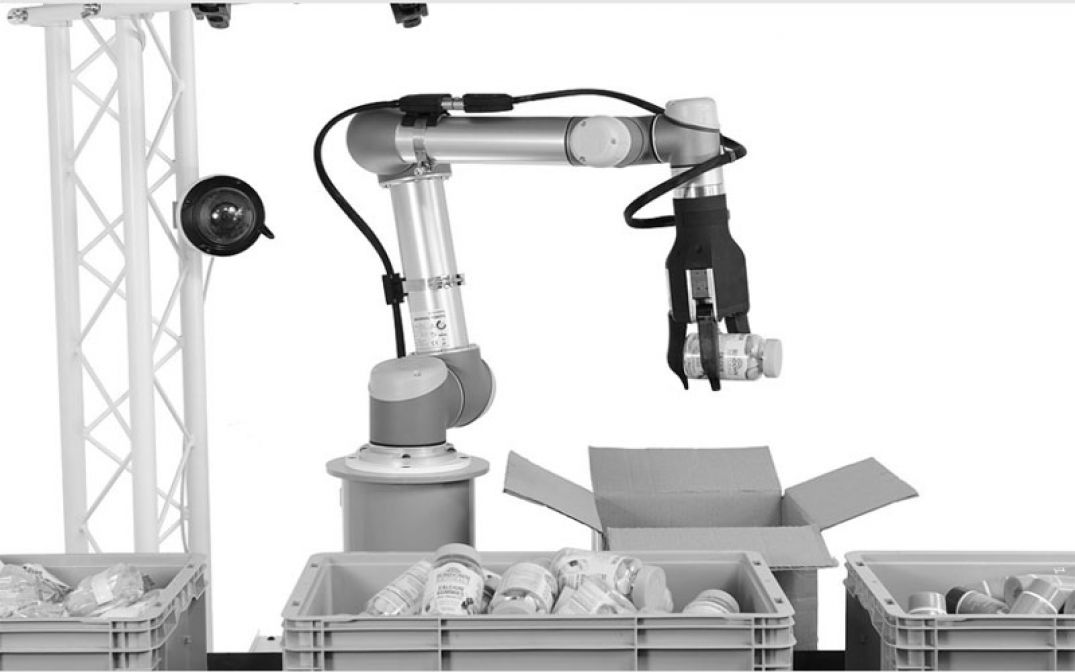
Robohub.org
Collaborative robotics at the Automate and ProMat trade shows

Six to ten years ago, exhibitors at Automate were promoting bin-picking in many, many booths. Bin picking wasn’t mentioned this year because it is an available option these days. For the last six years vendors have been promoting human-robot collaboration in manufacturing. Here’s what I saw this year at the big Automate and ProMat trade shows held last month in Chicago.
Chicago’s huge McCormick Place Conference Center was once again home to the Automate and ProMat trade shows: Automate for robotics; ProMat for material handling solutions. Over 900 exhibitors covered 350,000 sq ft at ProMat while 400+ companies exhibited at the Automate show.
Vendors appeared to be in the process of defining a broader definition of collaboration which includes all non-industrial robotics (mobile or stationary; manufacturing or service; professional or personal) in any way involving human-robot interaction. The interaction could be as little as different colored lights or as much as direct handling of materials back and forth to robots side-by-side on an assembly line.
Universal Robots (UR), the collaborative robot pioneer, has sold over 12,000 of their co-bots worldwide in their short career (they sold 52 in 2009). 2016 sales were 60% greater than 2015 and their goal for 2017 is 80% to 100% over 2016. UR’s booth, the biggest at Automate, was consistently crowded and noisy. Lots of attentive interest.
Recently UR added an app store for co-bot accessories, grippers and cameras. They presently offer 20 products but expect to have an additional 80 in the store by the end of 2017.
Another sign of UR’s success was the use of their robots in other vendor’s booths – 25 different exhibitors demonstrated their products with UR robots. Intelligrated used a UR to demonstrate their goods-to-picker application; Creaform used one equipped with their HandySCAN to demonstrate 3D scanning and inspection applications; ATI Industrial Automation used another UR outfitted with ATI’s multi-axis force sensor; Schunk used a UR to demonstrate their new CoAct EGP gripper (read more about this interesting gripper below) as did Robotiq, which used 3 UR’s to demonstrate their grippers, wrist cameras and force torque sensors.
Up until this year UR has had few active competitors. Most seemed to be waiting to see whether there’s a real market for these types of smaller, slower, less robust robots. They weren’t actively marketing their co-bot products.
- ABB and their two-armed YuMi (2-3 times as expensive as a UR)
- Fanuc’s CR-35iA, a green (for safe) soft-covered co-bot that can handle payloads of up to 75 pounds
- Kawada’s two-armed Nextage
- pi4 Robotics‘ Workerbots
- Kuka’s LBR iiwa which recently lowered its price to $60k
- Precise Automation’s SCARA and Cartesian desktop co-bots
- Rethink Robotics Baxter and Sawyer
UR and Rethink proved beyond doubt that there’s a willing marketplace for effective low-cost co-bot products, and the other companies are planning to take advantage of their many years of education and promotion. 2017 is the year many of the above companies – and many more new entrants – are beginning to seriously market into the industrial space. Here are some of the new co-bot entrants:
- The Aubo i5 (from the company that used to be called Smokie) looks like and has almost identical specs when compared to a UR5 except that it’s price is $10,000 less expensive and it has an open software system with ROS support.
- ABB plans to release a renamed version of the popular one-armed gomTec Roberta robot which was pulled from the market when ABB acquired gomTec.
- Bosch’s APAS which, although used internally for years is just beginning to be commercially marketed.
- Schunk’s stylish blue Powerball arm has been highlighted at every trade show so far this year.
- Denso is releasing their tiny desktop co-bot Cobotta.
- Kawasaki Robot is launching their duAro dual-arm SCARA co-bot and was using that co-bot to cone up and hand out soft-serve ice cream.
- Comau is launching their slick Racer 3 and 5 arms using their optional AURA add-on safety system.
- The highly anticipated Franka Emika $12,150 package of arm, gripper, teaching device and graphical software is already being delivered to academic clients. Commercial deliveries are expected shortly after this year’s Hannover Messe trade show.
- Staubli is launching their TX2 series of robot arms made safe by the optional use of their CS9 safety control system.
- And many more (read this article: 42 companies empowering robots and humans to work side-by-side).
Collaborative robots need safe, sensitive and flexible end-of-arm-tooling (EOAT) and there were many vendors – and some breakthrough technologies – demonstrated at the two shows. Details here: Smart grasping demonstrated at Automate and ProMat trade shows.
tags: Actuation, c-Events, cx-Industrial-Automation, cx-Research-Innovation, gripper, Industrial Other, review


